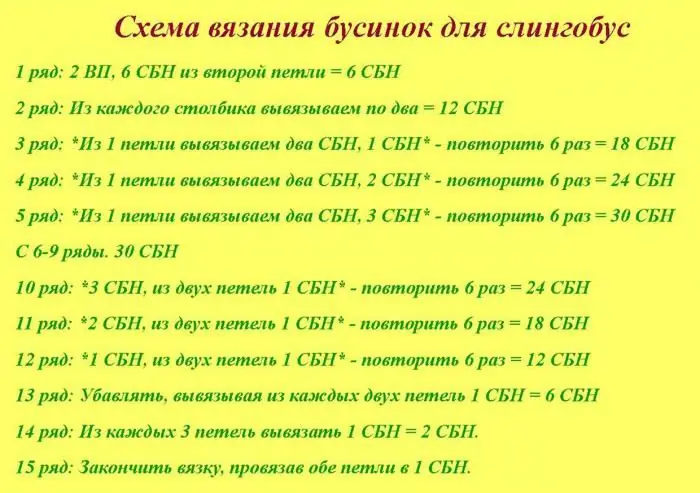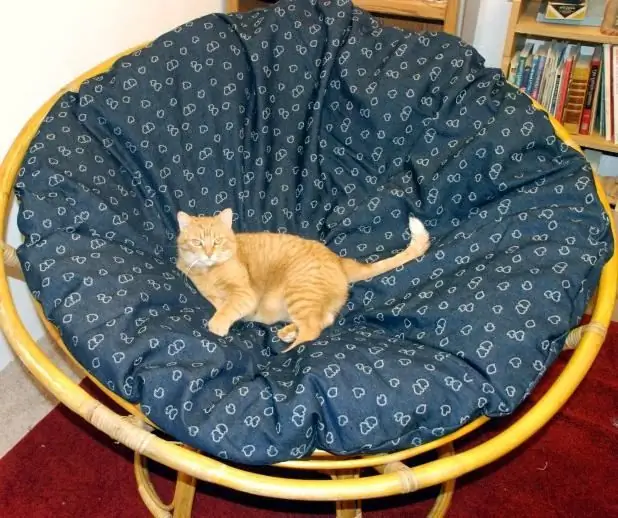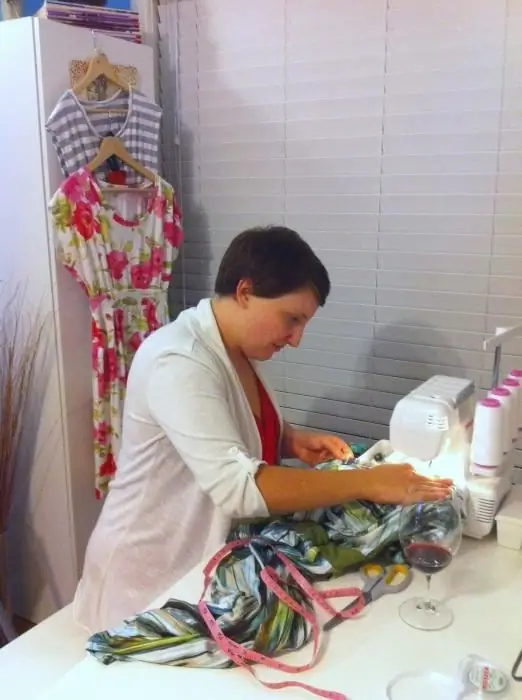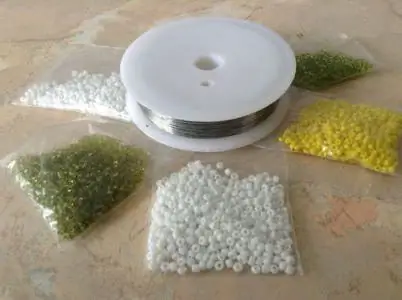
Inhaltsverzeichnis:
- Wofür wird Perlenstickerei verwendet
- Vielfältiges Material zum Arbeiten
- Werkzeuge und Materialien zum Verzieren mit Perlen
- Anfänger-Tipps zum erfolgreichen Arbeiten mit Perlen
- Perlen auf Stoff nähen: Anleitung für Anfänger
- Fixierung von Perlen mit "Klösterstich"
- Stiche "Stiel" und "Nadelrücken"
- Fotos abgeschlossener Arbeiten zur Inspiration
- Autor Sierra Becker [email protected].
- Public 2024-02-26 04:45.
- Zuletzt bearbeitet 2025-01-22 22:11.
Jedes Kleidungsstück, das mit Perlenstickerei verziert ist, sieht fantastisch aus! Und wenn Sie alle Dekorationsarbeiten selbst durchgeführt haben und sogar komplexe Schemata verwendet haben, ist dies im Allgemeinen ein Meisterwerk!
Die Beherrschung der Sticktechnologie ist eine ganz einfache Aufgabe - mit Erklärungen, wie man Perlen mit eigenen Händen auf Stoff näht, und Diagrammen, lass es uns gemeinsam herausfinden!
Wofür wird Perlenstickerei verwendet
Es ist möglich, absolut alles mit Perlenstickerei zu verzieren - von Kleidung und Schuhen (Kleider, Jeans, Blusen, bestickte Turnschuhe und sogar Ugg-Stiefel) bis hin zu Schmuck und Taschen. Es gibt viele Möglichkeiten zum Verzieren mit kleinen Perlen, die an den Beinen verstreut zu sein scheinen, einem sich wiederholenden Ornament, das entlang der Seitennaht oder des Ausschnitts verläuft, Blumen- und Pflanzenmotiven, Schmetterlingen, Bienen und anderen Insekten, "Gurken" usw.

Mit der Perlenstickerei stellen Nadelfrauen atemberaubenden Schmuck, Taschendekor und Haarspangen her.
Mit Stickereien lernt man ganz einfach, wie man Perlen auf Stoff nähtKleidung reparieren.
Vielfältiges Material zum Arbeiten
In einer Vielzahl von Warenangeboten können sich selbst erfahrene Handwerkerinnen, geschweige denn Stickanfänger, verirren. Daher lohnt es sich zu überlegen, in welche Arten dieses Material unterteilt ist:
- Plastikperlen - wird auch als Kinderperlen bezeichnet. Es ist kostengünstig und auf Kindersachen anwendbar.
- Bugle - regelmäßig und "schneidend", wenn die Schnittkanten schräg sind. Es wird aus geschnittenen Stücken von Glasröhren hergestellt. Unterscheidet seine helle Brillanz.
- Kleine Glasperlen in verschiedenen Formen - rund, zylindrisch, quadratisch.
- Japanisch, hat eine runde Form. Er wird über allen anderen geschätzt. Seine Qualität wird als die beste anerkannt und der Preis entspricht.
- "Pony" - mit länglicher Form, aus Kunststoff, Ton oder Glas.
- Perlen in Form von Knochen, Schmetterlingen - Barri.
- Perlen - Tropfen - Tropfen.
- Es gibt Perlen mit zwei Löchern, wie ein Knopf.

Beachten Sie bei der Auswahl von Perlen, dass die Japaner bei der Herstellung von Perlen höchster Qualität führend sind, gefolgt von den Tschechen und Taiwan. Gleichzeitig können taiwanesische Perlen völlig unterschiedlich sein - von ausgezeichnet bis ekelhaft.
Interessante Perlennummerierung - je höher der Zahlenwert, desto kleiner die Perle. Für Anfänger ist es optimal, Nummer 11 zu wählen.
Bevor Sie Perlen auf den Stoff nähen, achten Sie auf die Form - sie ist auch vielfältig, wählen Sie sie nach dem Muster aus, das Sie sticken möchten.
Bugle Perlen undStecklinge haben einen sehr hellen Glanz, der Nachteil ist, dass sie den Faden mit scharfen Kanten leicht schneiden. Wechseln Sie sie mit runden Perlen ab.
Werkzeuge und Materialien zum Verzieren mit Perlen
Die Wahl des richtigen Materials für Perlenarbeiten ist praktisch der wichtigste Schritt, denn in den Schaufenstern gibt es viele Handarbeitsprodukte.
Also, was brauchst du?
Der Faden ist ziemlich stark gewählt, ausgehend von der angewandten Arbeitsweise.
Nehmen wir an, dass für T-Shirts, Kleider, Pullover und andere Strickwaren spezielle Fäden verwendet werden - Lavsan, Kapron, und die Arbeit wird in 2 Fäden ausgeführt. Der Stich muss stark sein, um der Stickerei nicht nur Schönheit, sondern auch H altbarkeit zu verleihen.

Da es notwendig ist, Perlen mit unauffälligen Stichen auf den Stoff zu nähen, sind die Schattierungen der Fäden und die Grundlage, auf der die Stickerei ausgeführt wird, gleich.
Große Stickereien erfordern einen ernsthaften Ansatz. Führen Sie es auf einem separaten Stück Stoff aus und nähen Sie es dann vorsichtig an der richtigen Stelle. Das erleichtert Ihnen die Pflege Ihrer Kleidung - reißen Sie sie vor dem Waschen einfach ab.
Sticknadeln werden speziell genommen - Perlen. Sie sind dünner und haben viel engere Gewindelöcher.

Die Basis wird das Ding sein, auf dem sich das gestickte Muster befindet. Es können ganz unterschiedliche Materialien sein - Leder, Wildleder, Jeans, Strickwaren, Vliesversiegelung usw.
Anfänger-Tipps zum erfolgreichen Arbeiten mit Perlen
- Bereiten Sie sich einen bequemen Platz vor - sorgfältige Arbeit, Sie sollten sich wohl fühlen.
- Achte auf eine helle Schreibtischlampe.
- Nehmen Sie für die Arbeitsfläche ein weißes Tuch, die heruntergefallenen Perlen gehen nicht verloren.
- Es ist ratsam, nicht alle gekauften Perlen zu mischen - sortieren Sie sie nach Farbtönen.
- Das Stickmuster muss im Voraus vorbereitet werden.
- Lerne von billigen Perlen und billigem Stoff.
- Wählen Sie keine Perlen in Sondergröße, um Probleme mit Löchern und Nadeln zu vermeiden. Nimm Nummer 11 oder 12.
- Wechseln Sie erst nach einiger Erfahrung zu kleinen Perlen. Tun Sie es nicht sofort, um Enttäuschungen zu vermeiden.
Perlen auf Stoff nähen: Anleitung für Anfänger
Oft wird es als Grundlage für Stickereien verwendet. Wie näht man Perlen auf Stoff?
Es gibt eine Reihe individueller Merkmale. Verwenden Sie zur Erleichterung Ihrer Arbeit die folgenden Regeln:
Zeichnungen durch Kohlepapier direkt auf die Basis auftragen. Versuchen Sie erst, nachdem Sie Erfahrung (und viel!)
Stoff auf den Rahmen spannen oder einspannen.
Nehmen Sie Baumwoll- oder Nylonfaden.
Sticken Sie auf dunklen Stoffen mit gleichfarbigen Fäden. Bei hellen Fäden ist eine Auswahl an beigen, grauen oder weißen Fäden möglich.

Knoten zum Sichern des Fadens sind winzig, fast unsichtbar.
Nadel Nummer elfwird die beste Wahl sein.
Jeder der obigen Tipps wird Ihnen das Lernen erleichtern. Leidenschaft wird Sie nicht nervös machen, im Gegenteil, sie wird zu Entspannung und Entspannung führen.
Um den Vorgang genauer zu betrachten, versuchen Sie, ein einfaches Bild wie unten gezeigt zu erstellen.
Bereiten Sie die folgenden Werkzeuge vor:
- Rahmen oder Reifen.
- Perlen in verschiedenen Farbtönen.
- Grundstoff.
- Nadeln.
- Nylonfaden.
- Wachskerze.
Zeichne zu Beginn der Arbeit eine Skizze auf Papier oder nimm ein fertiges Diagramm.
- Material einspannen.
- Verwenden Sie Kohlepapier, um das Design vom Papier auf die Unterlage zu übertragen.
- Führe den Faden in die Nadel und verdrehe die Spitze zu einem kleinen Knoten.
- Am Anfang des Musters von innen eine Nadel und einen Faden ziehen.
- Setze die Perle auf die Nadel und stecke sie dann sehr nahe an der Perle in den Stoff und ziehe den Faden auf die falsche Seite.
- Machen Sie einen kleinen Stich und bringen Sie den Faden nach vorne.
- Nehmen Sie die nächste Perle und befestigen Sie sie auf die gleiche Weise.
- Damit sind alle Perlen fixiert und die äußerste auf der falschen Seite mit einem Knoten befestigt.
Perlen passen so eng wie möglich aneinander, aber ohne die Basis zu straffen - sonst gibt es F alten.
Sehen Sie, wie man Perlen auf Stoff näht, Foto:

Wir haben eine der Maschen untersucht, die als "Vorwärtsnadel" bezeichnet wird. Es gibt noch einige weitere Haupttypen.
Fixierung von Perlen mit "Klösterstich"
Die folgende Stickmethode wird zum Sticken von Symbolen und Bildern verwendet.
Wir bringen die Nadel nach vorne, es ist offensichtlich, sie fängt die Perle und ein Stich wird entlang der Schräge entweder nach unten oder nach oben gemacht. Ein Stich entspricht einer Perle. Die Hauptstichrichtung ist diagonal von der Außenseite der Stickerei, vertikal von der Innenseite.

Stiche "Stiel" und "Nadelrücken"
- Diese Methode ergibt eine sehr harte Oberfläche. Nachdem Sie die Nadel herausgezogen haben, legen Sie 2 Perlen darauf und bringen Sie die Nadel sofort sehr nahe an der zweiten Perle auf die falsche Seite. Kehren Sie zwischen ihnen nach oben zurück und führen Sie die Nadel durch Perle Nr. 2. Nehmen Sie sofort Perle Nr. 3 auf und führen Sie die Nadel auf die falsche Seite der Arbeit.
- Und wie näht man mit einer Nadel Perlen auf den Stoffrücken? Diese Methode ist dem „Stiel“sehr ähnlich, jedoch werden 2 oder sogar 4 Perlen auf einmal aufgesetzt. Ihre Anordnung ist freier, und der gestickte Teil ist viel weicher.

Fahren Sie so fort, bis die gewünschte Segmentlänge erreicht ist.

Für zusätzliche Steifheit gehen Sie zurück über ein Paar Perlen statt nur über eine.
Fotos abgeschlossener Arbeiten zur Inspiration
Und wie näht man Perlen auf den Stoff, damit die fertige Stickerei nicht klobig und klobig wirkt? Natürlich erh alten Sie beim ersten Mal kein Meisterwerk, aber mit etwas Geschick und Geschick, das im Laufe der Zeit erworben wird, werden sowohl Qualität als auch Schönheit kommen. Unten sind einige Fotos von Stickereien, die von erfahrenen Handwerkerinnen erstellt wurden.

So verwandelt sich eine einfache weiße Bluse.

Aber um solche glamourösen Sneaker wird jede Fashionista beneiden!
Studiere und du wirst Erfolg haben!
Empfohlen:
Wie man Slingo-Perlen mit eigenen Händen bindet. Wie man Slingo-Perlen häkelt

Heute ist es sehr in Mode gekommen, Schleuderbusse mit eigenen Händen herzustellen. Diesen süßen Mumienschmuck, den sie gerne wie gewöhnliche Perlen um den Hals trägt, können Babys zum Spielen oder sogar zum Kratzen des Zahnfleisches beim Zahnen verwenden
Wie man eine Lünette mit Bändern flechtet: Techniken für Anfänger und Beispiele mit Fotos

Wie man ein Stirnband mit Bändern verziert. Beschreibung der Techniken mit einem Tape oder zwei Tapes. Was ist die Kanzashi-Technik und wie können Sie damit das Stirnband mit Bändern flechten? Mit Blumen geschmückte Stirnbänder
Wie man mit eigenen Händen einen Stuhl baut. Wie man mit eigenen Händen einen Schaukelstuhl baut

Möbel können nicht nur aus Brettern hergestellt werden, sondern aus jedem verfügbaren Material. Die Frage ist nur, wie stark, zuverlässig und langlebig es sein wird. Überlegen Sie, wie Sie aus Plastikflaschen, Pappe, Weinkorken, Reifen und Faden einen Stuhl mit Ihren eigenen Händen herstellen können
Wie kann man Sommerkleider mit eigenen Händen nähen? Prozessfunktionen

Wer Sommer- oder Business-Sommerkleider mit eigenen Händen nähen möchte, braucht eine Maschine, Schnittmuster, Stoff, etwas Zubehör und etwas Geduld
Wie man Blumen aus Perlen webt: Diagramme, Fotos für Anfänger. Wie man Bäume und Blumen aus Perlen webt?

Perlenarbeiten, die von akribischen Nadelfrauen geschaffen wurden, haben noch niemanden gleichgültig gelassen. Es braucht viel Zeit, um Innendekorationen zu machen. Wenn Sie sich also für eine davon entscheiden, lernen Sie von einfachen, um die Grundprinzipien des Webens von Blumen aus Perlen zu beherrschen
